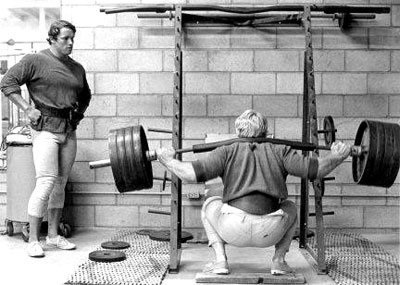Squats Must Be Done

Download the full Draper here newsletter
in printable, live-link, pdf format, here.
Upon our backs we bear the load. The pounds, the ounces are distributed in fine proportion throughout the structure from head to heel. We contract with all our might, not a tissue is spared the struggle. No man or woman can boast of exercise unless he or she performs the full squat.
That would be the same as swimming without water, football without goal posts or tennis minus the net. What senseless game might be played? No bar adorned with plates, no sturdy racks to approach with brave focus, no thick leather girding the back or ragged wraps about the knees? It's racing without the speed.
Squats must be done unless you are afflicted with fear, ignorance or physical limitation. The payoffs are big, well worth the investment of time and strain, and should be integrated into your training once conditioning is complete.
Let's delineate the statements of the preceding paragraph.
Fear is understandable; the prodigious bar balanced high upon the back in a position of little control, the long and unsteady descent to an unknown depth, the quivering, demanding ascent, the coordination of multiple muscles and the concern for health and life. How painful will it be, are they safe and will I topple?
With a slight adjustment of attitude, we can replace disabling fear with enabling caution.
Ignorance is dismissed once we unbury our heads and recognize the comprehensive strength-building benefits of squats, appreciate that they are a logical and natural workload and highly supported by the professional weightlifting and sports community. Upon the proper performance of squats, we are addicted to their mysterious allure.
Physical limitations, of course, need be dealt with individually. A partial squatting movement practiced with little or no weight might very well prove to be therapeutic, healing and enabling.
Big payoffs are visible in weeks as the overall strength of the body improves. The hefty demand on the entire structure causes an overall muscular response and positively affects the hormones of the system. Growth is stimulated. Muscle weight is gained. Heart and lung power is increased. Legs improve in shape and buttocks muscularize. The lower back and mid-section become stronger, more resistant and protective.
Before we can practice squats, it's wise to ready the ligaments and tendons that support the muscular-skeletal system in the heavy work. The muscles are ready, but the tough bands of connective tissue are not. A month of leg extensions and leg curls, leg presses and deep knee bends (two or three sets x 12 reps, twice per week… and don't forget calves, 3x20) will move us safely to the squat rack for our introductory sets. From there it is time and strain, strain and time.
The day has arrived. You're physically conditioned; you're psyched. The bar is on the rack before you. The first thing to try is three sets of 12 to 15 repetitions of moderate-weight leg extensions to prepare the knees and quadriceps for the work ahead. Note: You may feel more secure when squatting after having adequately trained your torso region -- muscles are warmed, activated and stabilized.
Your first set of squats is done with a forgiving attitude of experimental curiosity, an awkward trial and error approach to relax the stiffness within. Step to the bar (safely accessible, three inches lower than shoulder height), grasp it firmly at an appropriate distance to the left and right of the shoulders (12-15 inches) and assume a position under the bar that satisfies your sense of comfort and stability.
The positioning of the bar will require your close attention as you intuitively shift to correct all things: balance, sturdiness, courage, foot placement, knee action, lower back stress and shoulder comfort.
You are fully under the racked bar, feet shoulder-width apart, and have taken three deep breaths to assure sufficient oxygen uptake. Good. Stand upright, quickly assess your surroundings, step backward with an economy of movement to clear the racks and resume a shoulder-width stance.
Stabilize and focus. Slowly descend as if simply sitting onto a kitchen chair behind you. Your eyes remain fixed in a slightly upward gaze, buttocks go backward as you go down; your lower back, hips and knees bend in concert until your thighs are parallel to the floor. Up you go, pushing off with your heels.
Be careful not to tip forward, allowing the bar ascent to lag behind the leg thrust.
Once upright, take a deep breath and hold it while going back down, keeping the torso muscles tight. When you reach parallel, push up and exhale as you ascend.
That's two repetitions in all their flow and floundering. Don't stop now. The fun has just begun. Three sets of 12, 10 and 8 are a reasonable combination for your first weeks of interplay.
A trick for the tentative beginner: Set the safety bar on the racks to allow you to descend only 10 or 12 inches. This provides plenty of muscle action and movement to build strength, while building your confidence and exercise understanding. Lower the safeties as you progress from workout to workout.
Be careful always. The squat is a brilliant exercise that requires 100-percent focus, light weight or heavy.
Walking, running, jumping, climbing, kicking, dancing and staggering are made easier through squats.
Go.
Dave
*****
Take a trip over to our
Musclebuilding Q&A Blog
... where Dave allows us a peek into his email outbox.
Did you sign up for Dave's expanded email yet?
It's free, motivating and priceless!
We'll also send you a link to Dave's free
Body Revival Tips and Hints e-report with your confirmation notice.

